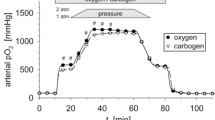Purpose:
Investigating tumor oxygenation in breast cancer with the Eppendorf device is hampered by the deep location and inadequate fixation of the tumor within the breast. In order to ensure the correct site of pO2 measurements, guiding aids were introduced and the reliability of the refined method was evaluated.
Material and Methods:
For guidance of the needle electrode, a metal trocar was inserted up to the tumor rim. Its positioning and all transtumoral tracks of the needle electrode were monitored continuously by ultrasonography. Thus, 150 tumor measurements in 148 patients were evaluated. In a phantom, the possible influence of the metal trocar was assessed and the measurements of two histographs with five different needle electrodes were compared.
Results:
In 88% of measurements (132/150) complete or partial sonographic demarcation of the tumor was possible. 83.2% of the tracks (437/525) could be controlled by ultrasonography. Overall, in 60% of measurements (90/150) all values derived reliably from within the tumor. In vitro, an influence of the metal trocar on the measurements could be excluded. Differences between histographs were in accordance with tolerance limits.
Conclusion:
From theoretical considerations and the phantom experiments a significant negative impact of the technical modifications could be excluded. Instead, the method described here showed to be beneficial in measuring tumor oxygenation in breast tumors. The authors strongly advise to consider exclusively intratumoral pO2 values as proven by ultrasonography for oxygenation profiling, as in 40% of all measurements the origin of single pO2 values or tracks was questionable.
Ziel:
Aufgrund der z. T. tiefen Lokalisation von Mammakarzinomen in der Brust und ihrer unzureichenden Fixierung im umliegenden Drüsengewebe sind diese Tumoren einer polarographischen Messung der Tumoroxygenierung mit dem Eppendorf-Histographen nur eingeschränkt zugänglich. Um jederzeit eine korrekte Lage der Messsonde zu gewährleisten, wurden Führungshilfen integriert und die Zuverlässigkeit der erweiterten Methodik evaluiert.
Material und Methodik:
Zur Führung der Nadelelektrode wurde ein Metalltrokar bis zum Tumorrand eingeführt. Dessen Positionierung und alle intratumoralen Messstrecken der Nadelelektrode wurden kontinuierlich mittels Ultraschall kontrolliert und so 150 Tumormessungen an 148 Patientinnen ausgewertet (Abbildung 1). Mögliche Einflüsse des Metalltrokars auf die Messergebnisse wurden an einem Phantom untersucht (Abbildung 2) und Messungen von zwei Histographen mit fünf verschiedenen Nadelelektroden verglichen.
Ergebnisse:
In 88% der Messungen (132/150) war der Tumor ganz oder teilweise sonographisch abgrenzbar. Die sonographische Kontrolle der einzelnen Messkanäle war in 83,2% (437/525) möglich (Tabelle 1). Insgesamt lag bei 60% aller Messungen jeder einzelne Messpunkt nachweislich intratumoral. Die In-vitro-Messungen ergaben keinen Einfluss des Metalltrokars auf die Messgenauigkeit der Histographen (Abbildung 3). Unterschiede zwischen Histographen blieben im Toleranzbereich (Abbildung 4).
Schlussfolgerung:
Anhand theoretischer Überlegungen und der Phantommessungen ist eine signifikante Beeinträchtigung des Messergebnisses durch die eingeführten technischen Modifikationen auszuschließen. Vielmehr erwies sich die hier beschriebene Methodik zur Bestimmung der Tumoroxygenierung im Mammakarzinom als vorteilhaft. Die Autoren empfehlen, ausschließlich Messwerte mit sonographisch nachgewiesener intratumoraler Herkunft zu verwerten, da in 40% der Messungen eine intratumorale Lage einzelner Messstrecken oder -werte fraglich war.
Similar content being viewed by others
Author information
Authors and Affiliations
Corresponding author
Rights and permissions
About this article
Cite this article
Auer, F., Röper, B., Scheich, D. et al. Technical Improvement of pO2 Measurements in Breast Cancer. Strahlenther Onkol 183, 265–270 (2007). https://doi.org/10.1007/s00066-007-1573-9
Received:
Revised:
Issue Date:
DOI: https://doi.org/10.1007/s00066-007-1573-9




